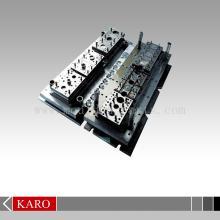Supplier: Injection Moulding Company
Contact person: Mr. Reus Lin
Position:
Address: 8356 W. Sunset Boulevard
Country: United States (USA)
Phone: +1(310)6425869 - Mobi:
Plastic Moulding
Price: USD 1500
I think you are talking about RTV which uses a prototype part which must be finished out very smooth. In this process you take the prototype and make a cavity and core using rubber. At this point the rubber will harden and a gate and vent will be added. Then they will pour a plastic that is mixed with hardner and dye of choice. the cemicals will take some time to set at which point the rubber parts will be seperated and you have your plastic part. This way is cheeper than plastic moulding but the life span of the tool is short depending on the complexity of the part.
Many companies manufacture high quality injection moulding but our company is one of the best in making good plastic mouldings. We routinely mold ultra-high heat resins modified with carbon, brass, stainless steel and flame retardant agents. If you want to get it then our company is the best.
Generally, the process of plastic moulding is ideal when looking to mould form: large shot weights, high volumes of small to medium size parts, incorporating bonded inserts, achieving close dimensional tolerances and making components that require uniformity or consistency of colour. This process is also best suited to those seeking much faster cycle times than that of traditional moulding techniques. Although it may have a higher initial set up cost, with machinery and tooling being fairly costly, injection moulding offers close tolerances on smaller, more intricate parts and less wastage, especially when thermoplastic waste seeing as the plastic can be crushed up and reused.
Mould making is never as cheap, quick or easy as you think it's going to be. Specialty software can help point you in the right direction but it isn't going to give you a quality end item. Milling a mold is as much an art as it is a science, one that requires experinced engineers and machinests to make. We are mould maker in China, our company a large-scale professional processing enterprise.
Many companies manufacture high quality injection moulding but our company is one of the best in making good plastic mouldings. We routinely mold ultra-high heat resins modified with carbon, brass, stainless steel and flame retardant agents. If you want to get it then our company is the best.
Generally, the process of plastic moulding is ideal when looking to mould form: large shot weights, high volumes of small to medium size parts, incorporating bonded inserts, achieving close dimensional tolerances and making components that require uniformity or consistency of colour. This process is also best suited to those seeking much faster cycle times than that of traditional moulding techniques. Although it may have a higher initial set up cost, with machinery and tooling being fairly costly, injection moulding offers close tolerances on smaller, more intricate parts and less wastage, especially when thermoplastic waste seeing as the plastic can be crushed up and reused.
Mould making is never as cheap, quick or easy as you think it's going to be. Specialty software can help point you in the right direction but it isn't going to give you a quality end item. Milling a mold is as much an art as it is a science, one that requires experinced engineers and machinests to make. We are mould maker in China, our company a large-scale professional processing enterprise.
SEND INQUIRY
Please fill in fully your information to send email
CATEGORY














 Agriculture
Agriculture